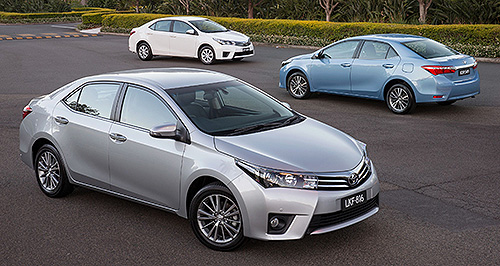Corolla sedan – the engineering story
BY BYRON MATHIOUDAKIS | 20th Feb 2014

According to Toyota Motor Corporation chief engineer of the ZE Product Planning Group, Shinichi Yasui, the company needed to ensure that the Auris was properly competitive against tough rivals including the Volkswagen Golf and Ford Focus.
This meant that the five-door led the engineering and design development in Nagoya, Japan, for the 11th-generation Toyota small car, with the latest Corolla sedan subsequently spun-off from there.
As a result, the sedan hits Australian showrooms 16-months after the hatch version - a longer wait between body-styles than is customary in the auto industry.
However, Mr Yasui said that the delay does not diminish the vital importance of the four-door, since it commands more than 80 per cent of Corolla/Auris sales globally – almost exactly opposite to the situation in Australia.
The goal, according to the 25-year Toyota engineering veteran, is for the Corolla to be an all-round better car than before as well as the world’s best selling nameplate, through advances in design, safety, ergonomics, value and quality.
With work on the new-comer commencing in 2008, the Corolla sedan is said to have been one of the most researched in the series’ 48-year history, with clinics held in many major markets including Australia during 2010.
Along with existing and previous Corolla owners, Toyota spoke to users of direct competitors such as the Honda Civic, Hyundai Elantra and Mazda3.
These, along with the Focus, GM Cruze and Volkswagen Jetta, became the sedan’s benchmarks.
Achieving class-leading rear-seat comfort, packaging and quietness was high on the to-do list, to satiate the needs of the high-volume US, Chinese, Indian and South American markets.
This led to a 100mm wheelbase stretch compared to the equivalent hatch, as well as larger door opening angles and a widening of the tracks over the old model.
Also, the boot is 20 litres bigger than before for better fitment of the inevitable golf clubs, with less intrusive wheel-arches and a wider aperture to help ease loading and unloading.
Most of the previous sedan’s modular platform structure (also shared with the current hatch, Ruckus, RAV4 and Prius) carries over, though much of the suspension and steering components have been modified.
Australia also played a role here, with engineers testing prototypes during early 2013, leading to “improved ride isolation and body control to suit Australia’s undulating country roads,” according to Toyota.
There is extra sound-proofing material behind the dashboard and near the wheel arch housings to help keep unwanted noise entering inside the cabin.
Although boosting the sedan’s dynamic appeal in order to lure in younger buyers was another engineering aim, the new model only offers the old torsion beam rear suspension system – even though a multi-link set-up is available on up-spec versions of the Auris in Europe.
Mr Yasui said keeping costs down was the motivating driver here, though there are also packaging benefits that come with the torsion arrangement due to its more compact arrangement.
Nevertheless, a lower centre of gravity does help with the Toyota’s improved dynamic capabilities, with a 5mm drop in the car’s hip point as a result of the seating being 8mm lower to the ground.
The steering wheel angle has been altered to feel “sportier” and there is a far-greater range of adjustment for both the steering column and the driver’s seat.
Furthermore, the body is stronger and more rigid than before, the brakes have been improved, and there is additional bracing fitted to key suspension components.
To improve drivetrain efficiencies, up to 30kg has been shaved off the Corolla sedan’s kerb weight tally through the use of lighter high-strength steel, many mechanical elements have been modified to reduce friction, while the switch to the CVT Continuously Variable Transmission ushers in a 10 per cent fuel economy gain compared to the old model with the four-speed automatic.
Toyota’s engineers also worked hard on smoothing out the underbody for better airflow properties, leading to a significant 0.04Cd drop in the sedan’s drag co-efficiency rating (down to 0.29Cd on the slipperiest versions). Aero foils on the exterior mirrors and tail-lights also help.
The Corolla sedan will be built in 16 plants and sold in over 150 countries.
Finally, Mr Yasui revealed that work is already well under way for the 12th-generation Corolla due in 2019 or 2020.
Beginning his career in airbag and other safety systems development at TMC in 1988, Mr Yasui has worked on the original 1998 Yaris-based Verso minivan (known as the Fun Cargo in Japan), as well as a series of other Toyota and Scion offshoots.
He has been closely involved with Corolla development since the ZZE120 series of 2001, and has been the chief engineer for both the latest 180-series hatch and 170-series sedan models.